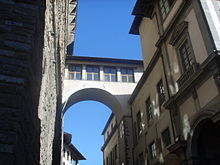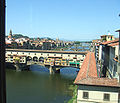Vasari Corridor

The Vasari Corridor (also Vasarianischer corridor; Italian : Vasari Corridor ) is a covered walkway in Florence , of the Palazzo Vecchio to the Palazzo Pitti connects while over the Ponte Vecchio to the Arno crossed. The total length of the Corridoio Vasariano varies between 800 and 1000 meters.
history
At the request of Grand Duke Cosimo I de 'Medici , the corridor was built between the months of March and December 1565, the architect Giorgio Vasari himself states in his autobiography that it was created a little less than five months. Vasari was Cosimo's chief court artist at that time and also supervised the work in the Palazzo Vecchio and the construction of the Uffizi . The reason for the construction was the parallel existence of two mansions - the Palazzo Vecchio on the north side and the Palazzo Pitti on the south side of the Arno - which had been in existence for around 15 years, and their connection via public roads and bridges represented a security risk for the Grand Duke. The immediate reason for the construction was the splendid wedding of Cosimo's son and later heir Francesco with Johanna of Austria on December 18 of that year, for which the corridor was to be presented to the guests and possibly used ceremonially. A model of the building can be seen, for example, in the medieval connecting passage of the Passetto di Borgo in Rome , which allowed the Pope to safely pass between Vatican City and Castel Sant'Angelo .
The original passage of the Vasari Corridor begins with a crossing of Via della Ninna between the Palazzo Vecchio and the second floor of the Uffizi Gallery. After crossing the Uffizi the visitor leaves the corridor the Uffizien building, enters an adjacent Palazzo and leaves it again on the height between the first and second floor in the direction Arno, where, after two right-angled bends of the canal on the Ponte Vecchio is guided . On the southern side of the Arno, the corridor initially crosses the medieval Mannelli tower , the further course from there leads over several streets and is partly supported by the walls of private buildings. In the church of Santa Felicita , the corridor opens to a gallery that allowed the grand ducal family to look into the nave and to attend mass. The direct access from the corridor to the gallery was later bricked up again. The window with a view of the gallery and the nave still exists today. The corridor leads from there to the Palazzo Pitti, where you can either enter the Boboli Garden at the level of the Grotta Grande or continue straight into the interior of the palace.
The crossing of the Torre dei Mannelli
Connection to the facade of the Santa Felicita Church
The last section of the corridor at Boboli Gardens
Since the 18th century, the corridor has been used to present a special genre of images from the holdings of the Uffizi Gallery - a large part of the artist self- portraits from the period between the 15th and 20th centuries. In the area between the Uffizi building and the bridgehead of the Ponte Vecchio, other Baroque paintings can also be seen. The Vasari Corridor can be visited today by appointment and only with a mandatory booking of a tour; However, due to the limited space and the special climatic conditions, the opportunity to visit is severely limited at several times of the year.
In March 2016, the director of the Uffizi, Eike Schmidt, announced his plan to move the collection of self-portraits to a more suitable location in the future, thus enabling tourists to visit the corridor without expensive booking. It is planned that in the future visitors to the Uffizi will be able to use a combination ticket to get directly to Palazzo Pitti via the corridor.
literature
- Leon Satkowski: Giorgio Vasari. Architect and Courtier. Princeton University Press, Princeton NJ 1993, ISBN 0-691-03286-6 , pp. 56-59.
- Claudia Conforti: Vasari architetto. Electa, Milan 1993, ISBN 88-435-4204-4 , pp. 160-190.
- Caterina Caneva (Ed.): Il Corridoio vasariano agli Uffizi. Banca Toscana, Florence 2002.
- Antonio Natali (Ed.): 100 autoritratti dalle collezioni degli Uffizi. Giunti, Florence 2008, ISBN 978-88-09-05813-2 .
Movie
- Michael Scott : Invisible Florence. Great Britain 2016 (Italy's Invisible Cities), German version 2017, 43 min. (Recordings based on 3D scans)
Web links
- Description of the corridor and pictures
- Marco Polo: Italy: In the Medici Secret Corridor , accessed on November 2, 2013
Individual evidence
- ↑ Chiara Dino: "Stop ai privilegi, Vasariano per tutti", in: Corriere Fiorentino , March 8, 2016, p. 3.





